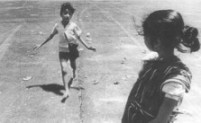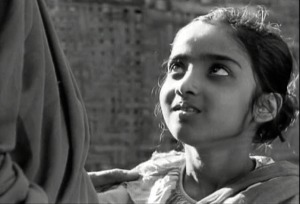Posts Tagged ‘ঋত্বিক ঘটক’
Posted by bangalnama on December 31, 2009
“With his very first film Udayer Pathe (Hamrahi in Hindi), Bimal Roy was able to sweep aside the cobwebs of the old tradition and introduce a realism and subtlety that was wholly suited to the cinema. He was undoubtedly a pioneer. He reached his peak with a film that still reverberates in the minds of those who saw it when it was first made. I refer to Do Bigha Zamin, which remains one of the landmarks of Indian Cinema.” – Satyajit Ray.
বিমল রায় কতটা উঁচু দরের পরিচালক ছিলেন তার স্বীকৃতি পাওয়া যায় ভারতীয় চলচ্চিত্রের প্রথম পুরুষ সত্যজিৎ রায়ের এই উক্তি থেকে। ‘বিমলদা’র চলচ্চিত্র জীবন শুরু কলকাতায় ক্যামেরাম্যান হিসাবে এবং পরবর্তী তিরিশ বছর তিনি সঁপে দিয়েছিলেন ভারতীয় সিনেমায়।
সন ১৯০৯-এর ১২ই জুলাই অধুনা ঢাকার এক জমিদার বাড়িতে জন্ম হয় বিমল রায়ের। জগন্নাথ কলেজে পড়াকালীন বাবা মারা যান এবং তার পরপরই জমিদারির এস্টেট ম্যানেজারের সৌজন্যে তাঁরা সর্বস্বান্ত হন। মা ও ছোট ভাইকে নিয়ে বিমলদা চলে আসেন কলকাতায়। ক্যামেরার প্রতি অসম্ভব ঝোঁক ছিল ছোটবেলা থেকেই। সেই সুবাদেই প্রমথেশ বড়ুয়ার ছায়াছবির প্রচারের জন্য ছবি তোলার কাজ পান। এর কিছুদিনের মধ্যেই নীতিন বোস তাঁকে নিউ থিয়েটার্সে ডেকে নেন সহকারী ক্যামেরাম্যান হিসেবে। প্রথম বড় মাপের সাফল্যের স্বাদ ১৯৩৫-এ প্রমথেশ বড়ুয়ার ‘দেবদাস’-এর সিনেমাটোগ্রাফার ও সহকারী পরিচালক হিসেবে। ৩০-এর দশকের শুরুতে ব্রিটিশ সরকারের হয়ে দুটি তথ্যচিত্র তৈরী করেছিলেন তিনিঃ ‘How Kerosene Tins are made’ আর ‘Grand Trunk Road’; কিন্তু এই ছবি দুটি নিয়ে আজ আর বিশেষ কোনো তথ্য পাওয়া যায় না। প্রমথেশ পড়ুয়ার সেই সময়ের ছবি ‘মুক্তি’, ‘মায়া’, ‘বড়ি দিদি’-তেও সিনেমাটোগ্রাফার ছিলেন বিমল রায়।
বাকি অংশটি এখানে পডু়ন…
Posted in সিনেমা, Thespian | Tagged: Amrit Kumbh, ঋত্বিক ঘটক, সত্যজিত রায়, Baap Beti, Badi Didi, Bandini, Benazir, Bimal Roy, Bimal Roy Production, Biraj Bahu, Bombay Talkies, Devdas, Do Bigha Zameen, documentaries, Gautama the Buddha, Grand Trunk Road, How Kerosene Tins are made, Humraahi, Immortal Stupa, Indian neorealist cinema, Life and Message of Swami Vivekananda, Madhumati, Maya, Mukti, Naukri, New Theatres, Nitin Bose, Parakh, Parineeta, Pramathesh Barua, Prem Patra, Sachin Dev Burman, Salil Chowdhury, Sujata, The Mahabharata, Udayer Pathe, Vittorio de Sica, Yahudi | 19 Comments »
Posted by bangalnama on August 31, 2009
In 1966, the writers of the Basic Development Plan for the city described Calcutta as a ‘metropolis in crisis.’ It was a description given in despair probably keeping in mind the city’s chequered history of urbanization. This urbanization was externally imposed by the English to meet the needs of a colonial economy and de-linked from the developments in the rural areas.1 The decade of the forties was characterized by major movements in population that stretched the limits of the city and its civic amenities, particularly the great famine of 1943 which took a toll of 6 million lives and pushed hundreds of people to seek relief into the city and its suburbs. After the Partition, the refugee movement greatly influenced the urbanization of the city because their sheer numbers transformed villages or semi urban areas to towns. In Calcutta, 25% of the metropolis agglomeration were refugees and between 1941 and 1951, Calcutta’s overall population density jumped by 20% while in areas with a large refugee presence like Tollygunj, the density increased by almost 141% within that same period.2
Read the rest of this entry »
Posted in উদ্বাস্তু ও জবরদখলকারী, কলকাতা, কলোনী, ক্যাম্প, পরিচয়, পরিযাণ, পূর্ব পাকিস্তান, বঙ্গভঙ্গ, রাজনীতি | Tagged: Amrita Bazar Patrika, Arun Mitra, ঋত্বিক ঘটক, সুনীল গঙ্গোপাধ্যায়, Benoy Ghosh, Bishnu Dey, Broto Chakraborty, Buddhadev Bose, Darshana, great famine of 1943, Jibanananda Das, Kolkatar Jishu, Manindra Roy, Naresh Guha, Nirendranath Chakraborty, partition of India, Premendra Mitra, refugees in Calcutta, Samar Sen, Sankho Ghosh, Sealdah Station, Udvastu | 4 Comments »
Posted by bangalnama on July 6, 2009
Women’s experience of the Partition is marked by large scale rape, abduction and forced marriage. It has received special attention of several scholars over the last few years, particularly since the 1990s. They have tried to understand the women’s experience of the Partition in terms of gender and patriarchy. Patriarchy constructs women in a peculiar way—her respectability is confirmed to the degree to which she is able to retain her sexual purity, her sexuality is a threat to her; her body is not her own, and it is not only the question of her own honour, but also that of her family and community. She is the repository of her community’s honour. Therefore, in a situation of conflict rape becomes a symbolic form of dishonouring the community. And it was so at the time of Partition too. It is interesting that both the rival communities shared the same patriarchal conception of rape. The honour paradigm of the rape culture was no less harmful to the women than the actual physical violence. Rapes were accompanied with large scale abduction and forced marriage. It was on the bodies of women that the new national border was marked out; the edifices of the two nation states in South Asia were constructed.
In 1993, Ritu Menon, Kamla Bhasin, Urbashi Butalia and Karuna Channa initiated a new kind of research on Partition experience from the perspective of gender. Their focus was primarily on the sufferings of the Punjabi women in the aftermath of Partition.1 Later Urbashi Butalia rightly pointed out a serious gap in the historiography of Partition – the omission of the experiences in Bengal and East Pakistan (Bangladesh), which, in her opinion, required detailed attention in their own right.2 Thereafter, initiatives were taken to reconstruct the Partition experience of the Bengali women, particularly the Bengali Hindu women.3
Read the rest of this entry »
Posted in উদ্বাস্তু ও জবরদখলকারী, কলকাতা, কলোনী, ক্যাম্প, পরিযাণ, বঙ্গভঙ্গ | Tagged: Alor Britte, Angapali, ঋত্বিক ঘটক, বঙ্গভঙ্গ, সত্যজিত রায়, Bakultala P. L. Camp, Balmeek, Chotonilpur Colony Burdwan, East Bengali refugee women, Ekti Shabder Mane, Epar Ganga Opar Ganga, Gargi Chakravartty, gender studies of partition, Green Belt Colony Nadia, Guilty, Jasodhara Bagchi, Jyotirmoyee Devi, Karun Kanya, Karuna Channa, Madhabi Mukhopadhyay, Mahanagar, Meghe Dhaka Tara, Miss Shefali, Nandalal Pal, Narayan Sanyal, Narendranath Mitra, Narir Katha, Natun Ihudi, Nivedita Devi, partition of India, partition of Punjab, Pasher Bari, Prafulla Roy, Rachel Weber, Ramapada Chowdhury, refugees at Sealdah station, Romesh Chandra Dutta, Sabitri Chattopadhyay, Salil Sen, Samaresh Basu, Santosh Kumar Ghosh, Saraswatibala Pal, Subharanjan Dasgupta, Subir Mukhopadhyay, The Trauma and the Triumph: Gender and Partition in Eastern India | 8 Comments »
Posted by bangalnama on January 23, 2009
(Continued from Part 1)
Of the musicians that hailed from the illustrious Bajaina Bari (House of Music) of Shibpur, Brahmanbaria, and the Seni-Maihar school, Alauddin Khan was undoubtedly the most influential. He lived for 110 years, played over 30 instruments from the string, wind, bow and percussion groups, was a master vocalist in dhrupad, dhamar and other traditional styles, composed several ragas, invented and modernized musical instruments, trained some of the most revered musicians of our times, and conceived the first ever musical orchestra in the history of Indian classical music. A larger-than-life portrait of Baba Alauddin Khan emerges from interviews and recounts given by the maestro himself and several of his students including Pandits Ravi Shankar and Nikhil Banerjee, Ustads Ashish Khan and Mobarak Hossain Khan, and filmmaker Ritwik Ghatak.

The early years
Towards the end of the 19th century, a child named Alam was born in the Khan household of Shibpur in rural Chittagong, bordering Tripura. “Ustad Alauddin Khan was my uncle”, writes Mobarak Hossain Khan. “We called him Laal Jetha. His complexion was ruddy, like raw turmeric, and hence the name, meaning ‘red uncle’.” He was an unusual child, a born vagabond, and became a musical prodigy very soon. He was sent to a Maktab to study when he was a child. But school was unattractive to the boy. He bunked classes regularly and instead, spent time in the local Kali temple, or on the ghats of the Titas, where sadhus and bauls would assemble to sing.
Read the rest of this entry »
Posted in চট্টগ্রাম, ফিরে দেখা, ব্রাহ্মণবেরিয়া, সংগীত | Tagged: Alauddin Khan, Ashish Khan, ঋত্বিক ঘটক, চট্টগ্রাম, ব্রাহ্মণবেরিয়া, chandra sarang, Maihar Band, Mobarak Hossain Khan, naltarang, Nikhil Banerjee, Ravi Shankar, saranga, Seni-Maihar gharana, Senia-Maihar, Siraju Dakaat, taalim, Tansen, Wazir Khan Beenkar | 25 Comments »
Posted by bangalnama on October 25, 2008
The trauma of refugee life and its piercing political cry forms the basis of Ritwik Ghatak’s sixth feature film— Subarnarekha (The Golden Line). The film seeks a further understanding of the semi-colonial Indian society after the transfer of power in 1947. Released in 1965, Subarnarekha is the last and the most complex of the trilogy that examines the socio-economic crisis of refugee life.
The narrative revolves around Ishwar Chakraborty, a refugee who stays in a refugee colony with h is younger sister Sita. There he discovers an abducted boy Abhiram and takes him under his wing. An old friend of Ishwar offers him a cashier’s job in an iron foundry at Chhatimpur near the bank of Subarnarekha. He accepts it and goes there with Sita and his new family member Abhiram. At Chhatimpur, across their house, the chi
is younger sister Sita. There he discovers an abducted boy Abhiram and takes him under his wing. An old friend of Ishwar offers him a cashier’s job in an iron foundry at Chhatimpur near the bank of Subarnarekha. He accepts it and goes there with Sita and his new family member Abhiram. At Chhatimpur, across their house, the chi ldren discover an abandoned airstrip and find it the most attractive playground. The childhood intimacy between Abhiram and Sita blossoms into mutual love, but keeping in mind Abhiram’s low caste origin, Ishwar turns down the marriage proposal. On her wedding night Sita deserts her brother and runs away with Abhiram, who takes bus driver’s job in Calcutta. They settle down in the city with their only son Binu. But tragedy comes to stalk their lives when Abhiram involves in an accident and gets killed by an irate mob. For the sake of her only son, Sita sinks into harlotry and out of utter shock discovers her brother, the drunken Ishwar as her first customer. The shock becomes unbearable and Sita kills herself. Frustrated Ishwar accepts Binu, his only relation, and starts off the journey to future.
ldren discover an abandoned airstrip and find it the most attractive playground. The childhood intimacy between Abhiram and Sita blossoms into mutual love, but keeping in mind Abhiram’s low caste origin, Ishwar turns down the marriage proposal. On her wedding night Sita deserts her brother and runs away with Abhiram, who takes bus driver’s job in Calcutta. They settle down in the city with their only son Binu. But tragedy comes to stalk their lives when Abhiram involves in an accident and gets killed by an irate mob. For the sake of her only son, Sita sinks into harlotry and out of utter shock discovers her brother, the drunken Ishwar as her first customer. The shock becomes unbearable and Sita kills herself. Frustrated Ishwar accepts Binu, his only relation, and starts off the journey to future.
Read the rest of this entry »
Posted in সিনেমা, Reviews | Tagged: ঋত্বিক ঘটক, সিনেমা, film, film reviews, movie, movies on partition, refugee, Subarnarekha, The Golden Line | 5 Comments »





